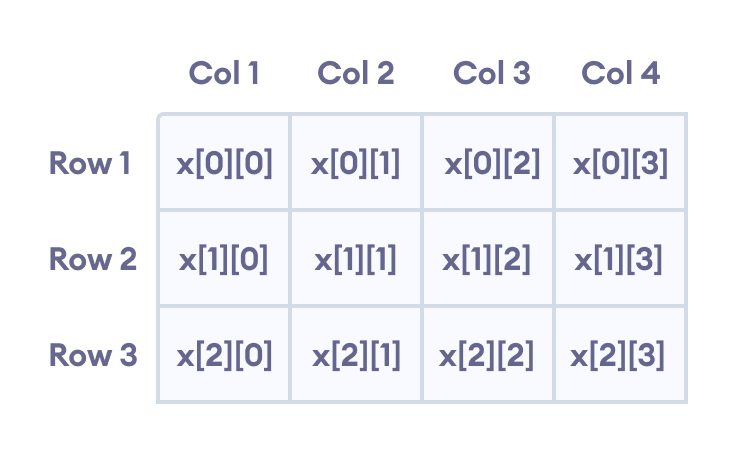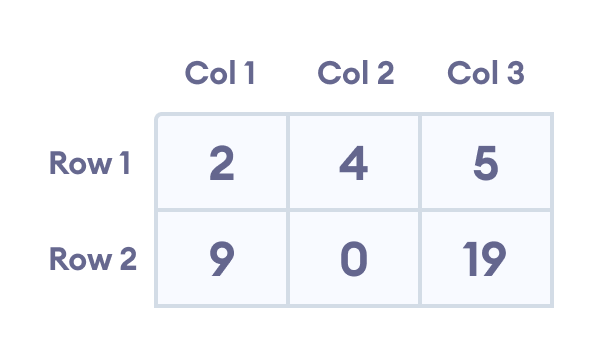📌 相关文章
- C++多维数组
- R中的多维数组
- C多维数组
- C++多维数组(1)
- R中的多维数组(1)
- C#多维数组
- C C++中的多维数组(1)
- C / C++中的多维数组
- C++多维数组(1)
- C#多维数组(1)
- C / C++中的多维数组
- JavaScript 中的多维数组(1)
- 多维数组javascript(1)
- JavaScript 中的多维数组
- Java中的多维数组(1)
- Java多维数组(1)
- Java中的多维数组
- 多维数组 java (1)
- Java多维数组
- PHP的多维数组(1)
- PHP的多维数组
- PHP的多维数组(1)
- PHP的多维数组
- PHP多维数组
- PHP多维数组(1)
- 多维数组javascript代码示例
- 数组和多维数组 - PHP (1)
- 多维 Java 数组 - Python (1)
- 多维数组 java 代码示例
📜 C++多维数组
📅 最后修改于: 2020-09-25 05:00:14 🧑 作者: Mango
在本教程中,我们将学习C++中的多维数组。更具体地说,如何在我们的程序中声明,访问它们以及有效地使用它们。
在C++中,我们可以创建一个数组的数组,称为多维数组。例如:
int x[3][4];在此, x是二维阵列。它最多可容纳12个元素。
我们可以将此数组视为具有3行的表,每行有4列,如下所示。

三维数组也以类似的方式工作。例如:
float x[2][4][3];该数组x最多可容纳24个元素。
我们可以简单地乘以数组的维数来找出数组中元素的总数:
2 x 4 x 3 = 24多维数组初始化
像普通数组一样,我们可以通过多种方式初始化多维数组。
1.二维数组的初始化
int test[2][3] = {2, 4, 5, 9, 0, 19};上述方法不是优选的。下面给出了使用相同数组元素初始化此数组的更好方法:
int test[2][3] = { {2, 4, 5}, {9, 0, 19}};该数组有2行3列,这就是为什么我们有两行元素,每行3个元素的原因。

2.三维数组的初始化
int test[2][3][4] = {3, 4, 2, 3, 0, -3, 9, 11, 23, 12, 23,
2, 13, 4, 56, 3, 5, 9, 3, 5, 5, 1, 4, 9};这不是初始化三维数组的好方法。初始化此数组的更好方法是:
int test[2][3][4] = {
{ {3, 4, 2, 3}, {0, -3, 9, 11}, {23, 12, 23, 2} },
{ {13, 4, 56, 3}, {5, 9, 3, 5}, {5, 1, 4, 9} }
};示例1:二维数组
// C++ Program to display all elements
// of an initialised two dimensional array
#include
using namespace std;
int main() {
int test[3][2] = {{2, -5},
{4, 0},
{9, 1}};
// use of nested for loop
// access rows of the array
for (int i = 0; i < 3; ++i) {
// access columns of the array
for (int j = 0; j < 2; ++j) {
cout << "test[" << i << "][" << j << "] = " << test[i][j] << endl;
}
}
return 0;
} 输出
test[0][0] = 2
test[0][1] = -5
test[1][0] = 4
test[1][1] = 0
test[2][0] = 9
test[2][1] = 1在上面的示例中,我们初始化了一个名为test的二维int数组,该数组具有3个“行"和2个“列"。
在这里,我们使用了嵌套的for循环来显示数组元素。
最后,我们在每次迭代中打印数组元素。
示例2:获取二维数组的输入
#include
using namespace std;
int main() {
int numbers[2][3];
cout << "Enter 6 numbers: " << endl;
// Storing user input in the array
for (int i = 0; i < 2; ++i) {
for (int j = 0; j < 3; ++j) {
cin >> numbers[i][j];
}
}
cout << "The numbers are: " << endl;
// Printing array elements
for (int i = 0; i < 2; ++i) {
for (int j = 0; j < 3; ++j) {
cout << "numbers[" << i << "][" << j << "]: " << numbers[i][j] << endl;
}
}
return 0;
} 输出
Enter 6 numbers:
1
2
3
4
5
6
The numbers are:
numbers[0][0]: 1
numbers[0][1]: 2
numbers[0][2]: 3
numbers[1][0]: 4
numbers[1][1]: 5
numbers[1][2]: 6在这里,我们使用了一个嵌套的for循环来获取2d数组的输入。取完所有输入后,我们使用了另一个嵌套的for循环来打印数组成员。
示例3:三维数组
// C++ Program to Store value entered by user in
// three dimensional array and display it.
#include
using namespace std;
int main() {
// This array can store upto 12 elements (2x3x2)
int test[2][3][2] = {
{
{1, 2},
{3, 4},
{5, 6}
},
{
{7, 8},
{9, 10},
{11, 12}
}
};
// Displaying the values with proper index.
for (int i = 0; i < 2; ++i) {
for (int j = 0; j < 3; ++j) {
for (int k = 0; k < 2; ++k) {
cout << "test[" << i << "][" << j << "][" << k << "] = " << test[i][j][k] << endl;
}
}
}
return 0;
} 输出
test[0][0][0] = 1
test[0][0][1] = 2
test[0][1][0] = 3
test[0][1][1] = 4
test[0][2][0] = 5
test[0][2][1] = 6
test[1][0][0] = 7
test[1][0][1] = 8
test[1][1][0] = 9
test[1][1][1] = 10
test[1][2][0] = 11
test[1][2][1] = 123d阵列的打印元素的基本概念类似于2d阵列的打印概念。
但是,由于我们要处理3个维度,因此我们使用嵌套的for循环,其中包含3个循环,而不仅仅是2个循环。
如我们所见,数组的复杂度随尺寸的增加而呈指数增加。